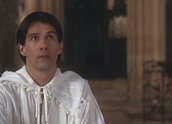


Black Robe (1991)
Synopsis
In 1634, French Jesuit priest Father Laforgue (Lothaire Bluteau) leaves the fledgling colonial settlement of Quebec in Canada via canoe to join fellow missionaries who have settled up river with the Huron tribe. Accompanying Laforgue is a young Frenchman, Daniel (Aden Young), and, to protect them, a party of Algonquin led by the proud Chomina (August Schellenberg).
The Algonquin have formed a seemingly friendly relationship with the white settlers based on trade, but underlying tensions quickly rise to the fore as the party travels up river. After consulting a shaman from a group of Montagnais tribesmen, the Algonquin abandon Laforgue, quickly followed by Daniel, who’s fallen for Chomina’s daughter, Annuka (Sandrine Holt).
The two parties reconcile but it’s not long before they encounter a war-like party of Iroquois and Laforgue’s mission looks increasingly doomed. As he confronts the possibility of imminent death, the Jesuit begins to question his faith.
Curator’s notes
This Australian-Canadian co-production, lucidly adapted by Canadian author Brian Moore from his 1985 novel, is one of the most powerful and accomplished films made by an Australian director in the 1990s. It stands as a highlight of Bruce Beresford’s extensive career as a director, which includes Don’s Party (1976), Breaker Morant (1979), Mao’s Last Dancer (2009) and the Oscar-winning US films Tender Mercies (1983) and Driving Miss Daisy (1989).
At the same time it remains a film whose rediscovery is arguably overdue. Black Robe’s under-recognition in Australia is perhaps because it is so obviously a Canadian story, though Australian creatives were involved in its production including Beresford’s regular director of photography, Peter James, and co-star Aden Young (making his film debut). The film was also post-produced in Sydney.
An immediately striking aspect of the production is its evocation of the harshness and danger faced by both Indigenous people and settlers on the frontier. The travel journals of 18th century US historian Francis Parkman were an important source of anthropological detail for both novelist Moore and for Beresford in pre-production. But this is not a dry anthropological treatise, rather a drama themed around the mutual suspicion and incomprehension of these massively different cultures.
In some ways the film resembles a western, albeit one set in far colder climes than the genre usually portrays. Superficially there are some parallels with Kevin Costner’s Dances With Wolves (1990) in the contrast between friendly and cruel native American tribes. However Moore’s script is far less romanticised; he is keen to point out that the hostile Iroquois – whose ferocity makes an especially strong impact in the film’s final third – are essentially not so different to the friendlier Algonquin, who are driven by the desire for trade rather than any higher aspirations.
Father Laforgue is a protagonist without macho qualities. He has more in common with Max von Sydow’s knight in Ingmar Bergman’s The Seventh Seal (1957), a European art film set in a similarly harsh environment (during the medieval Black Plague), than with male western heroes. Morally the film is admirably multifaceted – on one hand displaying the purity of Laforgue’s spirituality and faith, yet showing how those qualities lead to an unconsciously arrogant, colonialist determination to foist European religion onto another culture.
The film’s central irony is that, despite their massive cultural differences, the powerful belief systems of the Jesuits and the Algonquin are in essence not so far removed. It matters more that they share a concern for spirituality than that their interpretations widely differ, and the tragedy at the heart of the film is that Larforgue is unable to recognise this.
Black Robe was released in Australian cinemas on 27 February 1992. It was nominated for ten AFI Awards in 1992: Best Picture, Director, Actor (Lothaire Bluteau), Supporting Actor (August Schellenberg), Screenplay (Brian Moore), Editing (Tim Wellburn), Original Music (Georges Delerue), Sound (Phil Judd, Penn Robinson and Gary Wilkins) and Costume Design (Renée April and John Hay), winning the award for Cinematography (Peter James).
Black Robe won six Canadian Genie awards in 1991: Best Picture, Direction, Supporting Actor (August Schellenberg), Adapted Screenplay, Cinematography and Art Direction (Gavin Mitchell and Herbert Pinter); it was also nominated for Supporting Actress (Sandrine Holt), Editing, Original Music and Costume Design.
- Overview
- Curator’s notes
- Video 3 clips
- Principal credits
- Find a copy
- Make a comment
- Map
- Add your review



